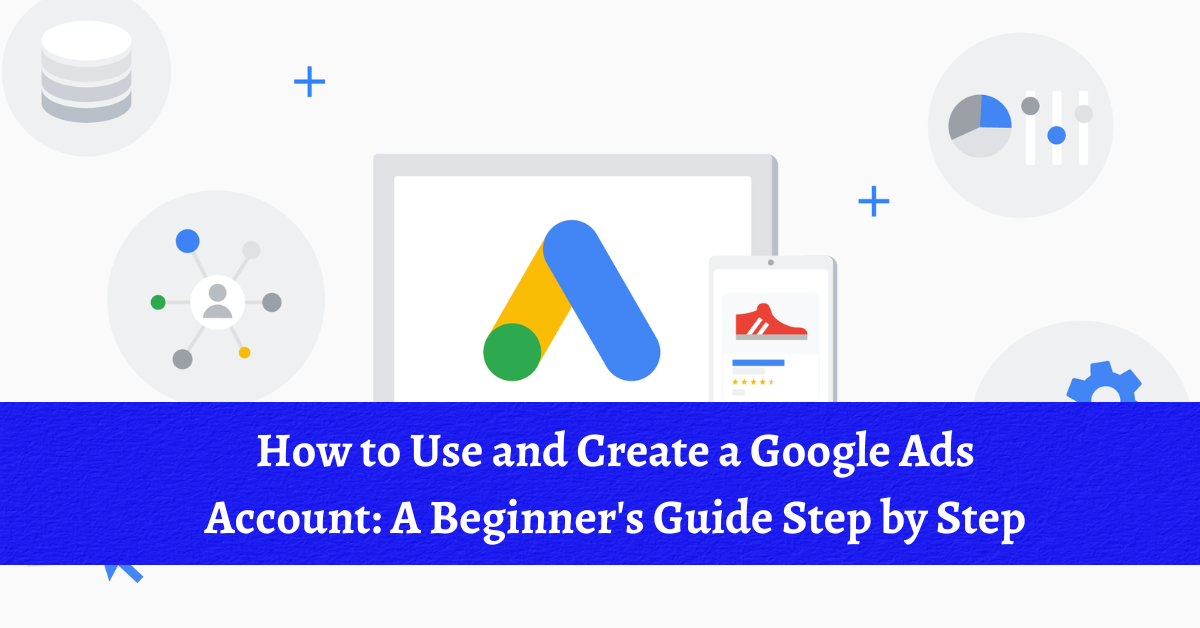Introduction to Google Ads
An online advertising network called Google Ads, formerly known as Google AdWords enables companies to place advertisements on Google’s search engine results pages (SERPs) as well as on partner websites and mobile applications. It operates on a pay-per-click (PPC) paradigm, where advertisers only get paid when someone clicks on their adverts.
You can use your Gmail account to access and manage your Google Ads account, making it easier to control your advertising campaigns and track their performance.
In addition to text ads, Google Ads also provides display ads, video ads, and ecommerce ads. Businesses can reach prospective clients who are actively looking for goods or services connected to their offerings in a highly focused and economical way with this method.
1. Setting up Your Google Ads Account

Create an account first before you can begin using Google Ads. Create a Google Ads account by following these steps:
Step 1: Go to the Google Ads website
Visit the Google Ads website (https://ads.google.com) by launching your browser.
Step 2: Sign in with your Google account
Sign in with your existing information if you already have a Google account (such as a Gmail account). In the event that this does not work, click the “Start Now” button and adhere to the directions to make a new Google account.
Step 3: Create your first campaign

The first campaign you build after signing in will be requested of you. Choose a campaign type, such as Search, Display, Video, or Shopping, that corresponds with your advertising objectives.
Step 4: Set up your campaign settings
Give your campaign a name, decide which area of the world you want to target, decide how much money you want to spend each day, and decide which networks you want to run your ads on. Other targeting variables, such as language preferences, and device targeting, can also be specified.
Step 5: Create your ad groups and ads
Make ad groups for each of the distinct topics or product categories that you want to promote in your campaign. Make appropriate advertisements that will be shown to your target audience for each ad group. The distinctive selling characteristics of your goods or services should be highlighted in persuasive advertising copy.
Step 6: Define your keywords
Your advertising will appear when visitors input certain search terms, which are known as keywords. For your firm, conduct keyword research to find the most appropriate terms. To generate keyword suggestions and gauge their search traffic, make use of tools like the Google Keyword Planner.
Step 7: Set your bids and budget
Make a decision regarding the cost per advertisement click that you are willing to pay. Your advertising budget and the difficulty of your keywords should be taken into account when setting your bids. To maximize your return on investment (ROI), keep an eye on the progress of your campaign and modify your bids as necessary.
2. Understanding Campaigns and Ad Groups
Campaigns are divided up into ad groups in Google Ads. A group of advertising with a similar theme or target demographic makes up an ad group, whereas a campaign is a collection of connected ads and settings. For managing and improving your advertising campaigns, it is essential to structure your ad groups and campaigns well.
3. Keyword Research and Selection
For Google Ads campaigns to be effective, keyword research is an essential stage. It aids in locating the search terms and keywords that are most pertinent to your industry and most likely to bring highly qualified visitors to your website. You can make sure that the proper audience sees your advertising at the right moment by choosing the appropriate keywords.
4. Creating Compelling Ad Copies
Developing engaging ad copy that captures the attention of your target audience is crucial to attracting clicks and producing conversions. Your ads must clearly state the advantages of your goods or services and contain a compelling call-to-action (CTA) that nudges readers to take an action, such as making a purchase or completing a form.
5. Targeting and Ad Placement
In order to help you find your target audience, Google Ads offers a variety of targeting choices. Users can be targeted based on their geographic location, language choices, device types, and even particular demographics. You also have a choice as to where your advertising will display, such as on Google search results pages, partner websites, or YouTube videos.
6. Bidding Strategies and Budgeting
According to your chosen bid strategy, Google Ads will adjust your bids to help you reach your advertising objectives. A variety of bidding techniques are available, including target return on ad spend (ROAS) bidding, automated bidding, and human bidding. Choose the best bidding approach for your campaigns by carefully taking into account your goals and budget.
7. Tracking and Measuring Performance
To assess their efficacy and make data-driven adjustments, it is essential to track and measure the performance of your Google Ads campaigns. Create a conversion tracking setup to keep track of user behaviors such as purchases, form submissions, and newsletter signups that occur after they click on your adverts. To learn more about how people are using your website and to spot areas for development, utilize Google Analytics.
8. Optimizing Your Campaigns
Success with Google Ads is mostly dependent on ongoing optimization. Examine the results of your campaign on a regular basis, spot any underperforming advertisements or keywords, and then make the necessary improvements. To determine the most productive combinations that produce the best results, test various iterations of your ad copy, landing page, and targeting settings.
9. Advanced Features and Tools
A variety of cutting-edge features and tools are available in Google Ads to help you improve your advertising efforts. These consist of ad extensions, which enable you to offer further details or choices besides your adverts, such as phone numbers, website URLs, or call buttons. If you want to target particular consumer categories, look into capabilities like audience targeting and remarketing, which let you target visitors who have already visited your website.
10. Ad Extensions and Additional Ad Formats
You have more options with ad extensions to improve the relevance and interest of your advertisements. To increase the visibility of your ads and generate more clicks, use ad extensions such as call extensions, location extensions, and promotion extensions. To diversify your ad creatives and cater to varied audience tastes, try out several ad formats, such as responsive search advertising or picture advertisements.
11. Google Ads Training Resources
To assist you in mastering the use of Google Ads, Google offers a multitude of learning tools. Check out the Google Ads Help Center for step-by-step instructions, tutorials, and troubleshooting advice. Make use of the Google Ads certificates to demonstrate your knowledge and build your reputation as a Google Ads marketer.
Conclusion
With the aid of Google Ads, companies of all sizes can connect with their target market and meet their marketing objectives. You now possess a thorough knowledge of how to set up and utilize a Google Ads account by following this beginner’s guide. To maximize your return on investment, keep in mind to constantly review and tweak your efforts. Start using Google Ads now to maximize the benefits of online marketing for your company.
Frequently Asked Questions (FAQs)
Q1: How much does it cost to advertise with Google Ads?
A: Depending on your bidding strategy, the level of industry competition, and the effectiveness of your ads, the cost of advertising with Google Ads fluctuates. It is possible to define your own spending limits and budget.
Q2: Can I use Google Ads to promote my local business?
A: You can reach visitors in particular regions using the targeting options available in Google Ads. By promoting your neighborhood business, you can draw local clients.
Q3: Are there any promotional codes or coupons available for Google Ads?
A: On occasion, Google gives new advertisers discount codes or vouchers. On the Google Ads website, keep an eye out for such deals, or ask Google Ads support whether any continuing promotions are available.
Q4: Is it necessary to sign up for Google AdSense to use Google Ads?
A: No, Google AdSense is a different service that enables website owners to monetize their online content by displaying Google adverts. Using Google Ads to promote your business does not require you to sign up for AdSense.
Q5: Where can I find training resources to learn more about Google Ads?
A: Google Ads offers a variety of training tools, including the Google Ads Help Center, online programs, and certifications. You may learn how to efficiently use Google Ads by using these resources.







